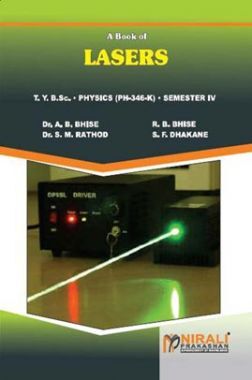Lasers deliver coherent, monochromatic, well-controlled, and precisely directed light beams. A priori, therefore, lasers would seem tobe poor choices for general-purpose illumination, however, they are ideal for concentrating light in space, time, or particular wavelengths. Introduction to Lasers Laser is an acronym for “Light Amplification by Stimulated Emission of Radiation” In 1960 laser was introduced as an appealing method for the production of highly directional, coherent, monochromatic and polarized light beam. Unit –I LASER Engineering Physics Introduction LASER stands for light Amplification by Stimulated Emission of Radiation. The theoretical basis for the development of laser was provided by Albert Einstein in 1917. In 1960, the first laser device was developed by T.H. AN INTRODUCTION TO PHYSICS This course of 45 video lectures, as well as accompanying notes, have been developed and presented by Dr. Pervez Amirali Hoodbhoy, professor of physics at Quaid-e-Azam University, Islamabad, for the Virtual University of Pakistan, Lahore.
Before going into how LASER (Light Amplification by Stimulated Emission of Radiation) works, let’s first take a look at how light works.
Introduction To Laser Physics Shimoda Pdf
What is Light?
Light is a kind of energy released by an atom. Light is made up of very small particles called photons.
Atoms are the basic units of matter. Each atom consists of a nucleus and a set of electrons orbiting the nucleus.

Nucleus is formed as a result of strong nuclear force between the protons and neutrons. Protons have positive charge so they are referred as positively charged particles. Neutrons do not have charge so they are referred as neutral particles.
Neutrons do not have charge so the overall charge of the nucleus is positive.Electronshave negative charge so they are referred as negatively charged particles. Electrons always orbit the nucleus because of the electrostatic force of attraction present between them. Electrons revolve around the nucleus in different orbits or shells. Each orbit has a unique energy level.
Theelectrons orbiting at a larger distance from the nucleus have higher energy level whereas the electrons orbiting at a smaller distance from the nucleus have lower energy level.
Theelectrons in the lower energy level need some extra energy to jump from lower energy level to the higher energy level. This extra energy can be supplied from various types of energy sources such as heat, electric field or light.
Light shows properties of both waves and particles so it can behave simultaneously as a particle or a wave. Einstein believed that light is a particle or photon andthe flow of photons is a wave. Light is obtained from various sources like candles, lamps and sun-rays.
Candles and lamps are called as the man made light sources and sun-rays is called natural light source.
The first reliable artificial light source (incandescent light bulb) was invented in 1879 by Thomas Edison. In incandescent light bulb, electric current flows through a filament inside the bulb.
Whensufficient electric current is passed through the filament, it gets heated up and emits visible light. Thus, visible light is emitted from the incandescent light bulb.
What is a LASER?
The word LASER is an acronym for Light Amplification by Stimulated Emission of Radiation. Laser is a device that amplifies or increases the intensity of light and produces highly directional light.
Laser not only amplifies or increases the intensity of light but also generates the light. Laser emits light through a process called stimulated emission of radiation which amplifies or increases the intensity of light. Some lasers generate visible light but others generate ultraviolet or infrared rays which are invisible.
In general, when electron jumps from a higher energy level to a lower energy level, it emits light or photon. The energy of the emitted photon is equal to the energy difference between the energy levels. The loss of electron energy is attributed to the entire atom. Therefore, it can be thought that the atom is moving from a higher energy state to a lower energy state.
Laser light is different from the conventional light. Laser light has extra-ordinary properties which are not present in the ordinary light sources like sun and incandescent lamp.
Laser Theory Pdf
Theconventional light sources such as electric bulb or tube light does not emit highly directional and coherent light whereas lasers produce highly directional, monochromatic, coherent and polarized light beam.
Inconventional light sources, excited electrons emit light at different times and in different directions so there is no phase relation between the emitted photons.
On the other hand, the photons emitted by the electrons of laser are in same phase and move in the same direction.
Einsteingave the theoretical basis for the development of laser in 1917, when he predicted the possibility of stimulated emission. In 1954, C.H. Townes and his co-workersput Einstein’s prediction for practical realization.
Theydeveloped a microwave amplifier based on stimulated emission of radiation. It was called as MASER (Microwave Amplification by Stimulated Emission of Radiation. Maser operates on principles similar to laser but generates microwaves rather than light radiation.
In 1958, C.H. Townes and A. Schawlow extended the principle of masers to light. In 1960, T.H. Maiman built the first laser device.
These unique characteristics of laser have made it an important tool in various applications. The initial notable application of laser was made c on the lunar ranging experiment of Apollo II Mission of 1969, when an array of retro reflectors was mounted on the surface of the moon and pulses from a ruby laser were sent from the earth. The reflected beams were received by suitable detectors and by measuring the time taken by the pulses in going from the earth to the moon and back, the distance of the moon from the earth was calculated to an accuracy of 15 cm.Laser Physics Ppt


Laser Basics Pdf
Laser Physics Textbook Pdf
* Click on the 'file icon' or 'file name' to start downloading